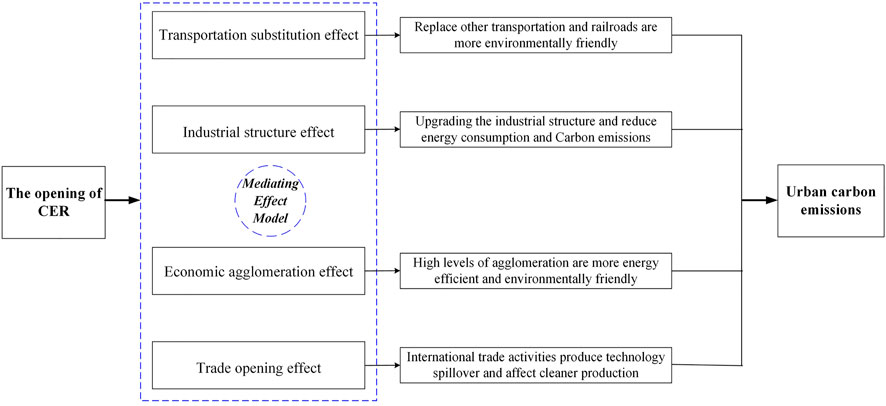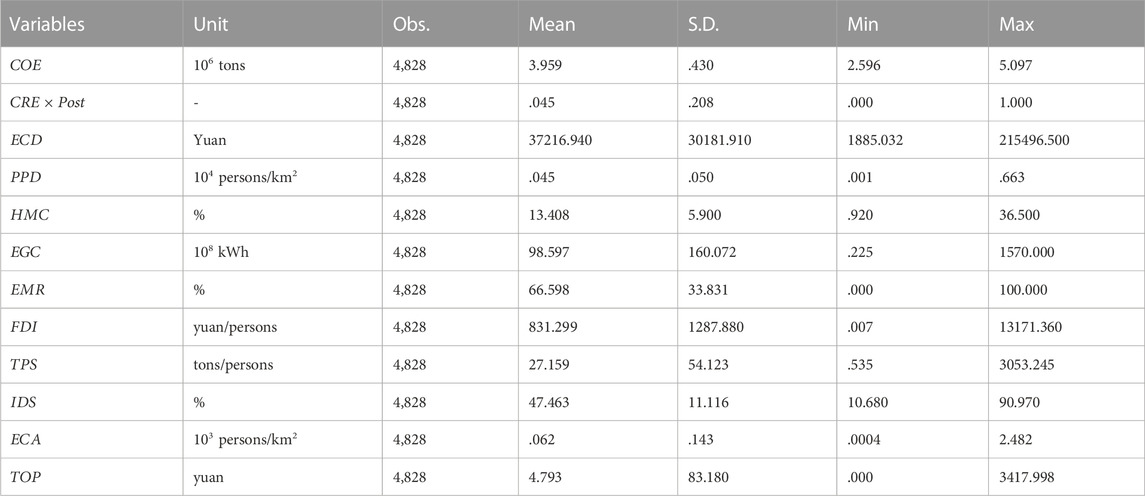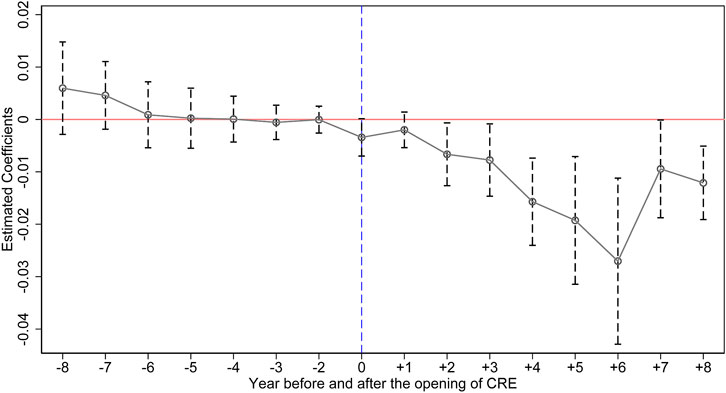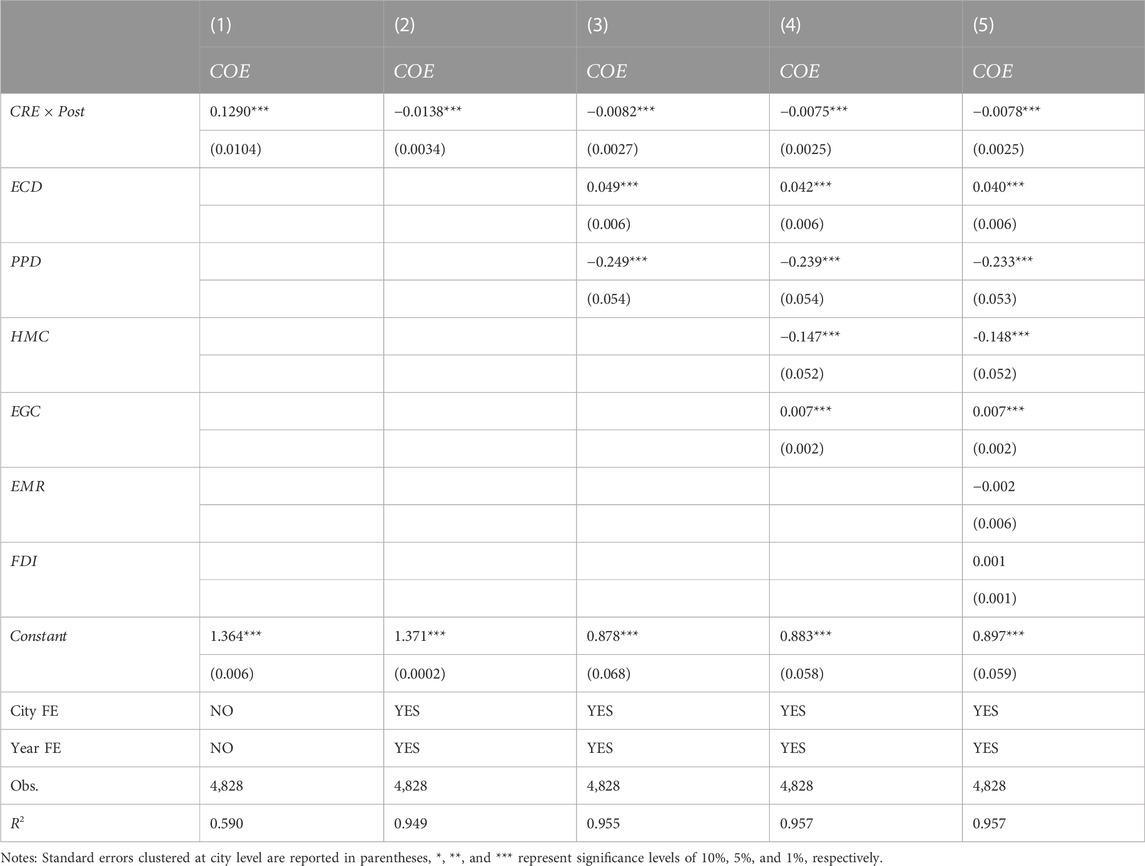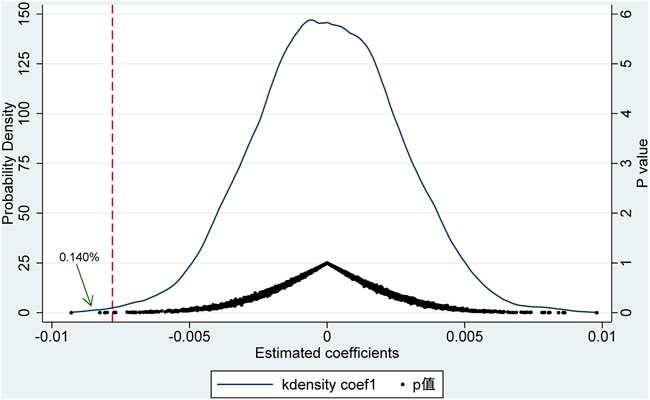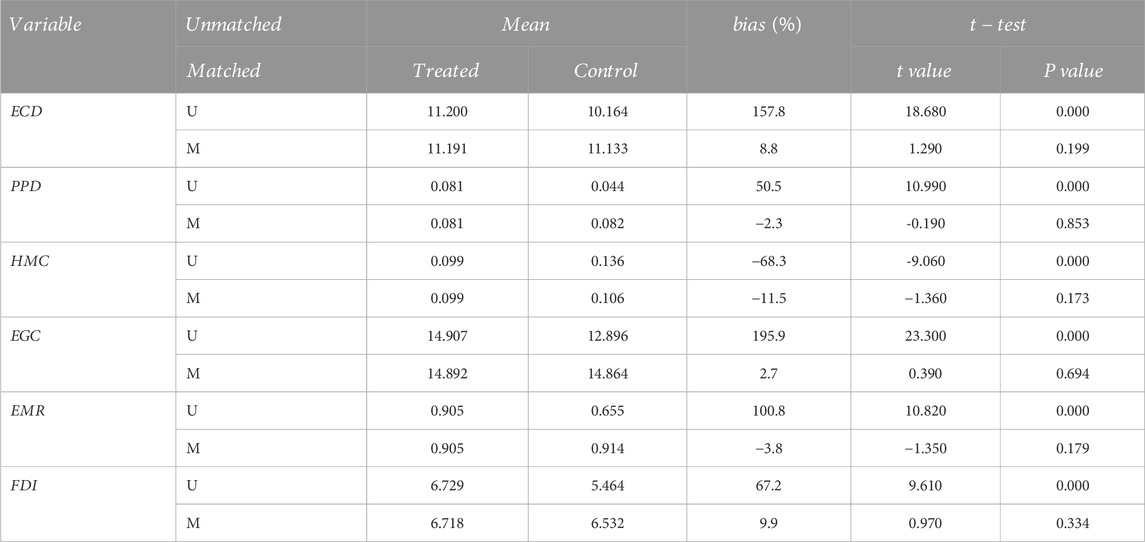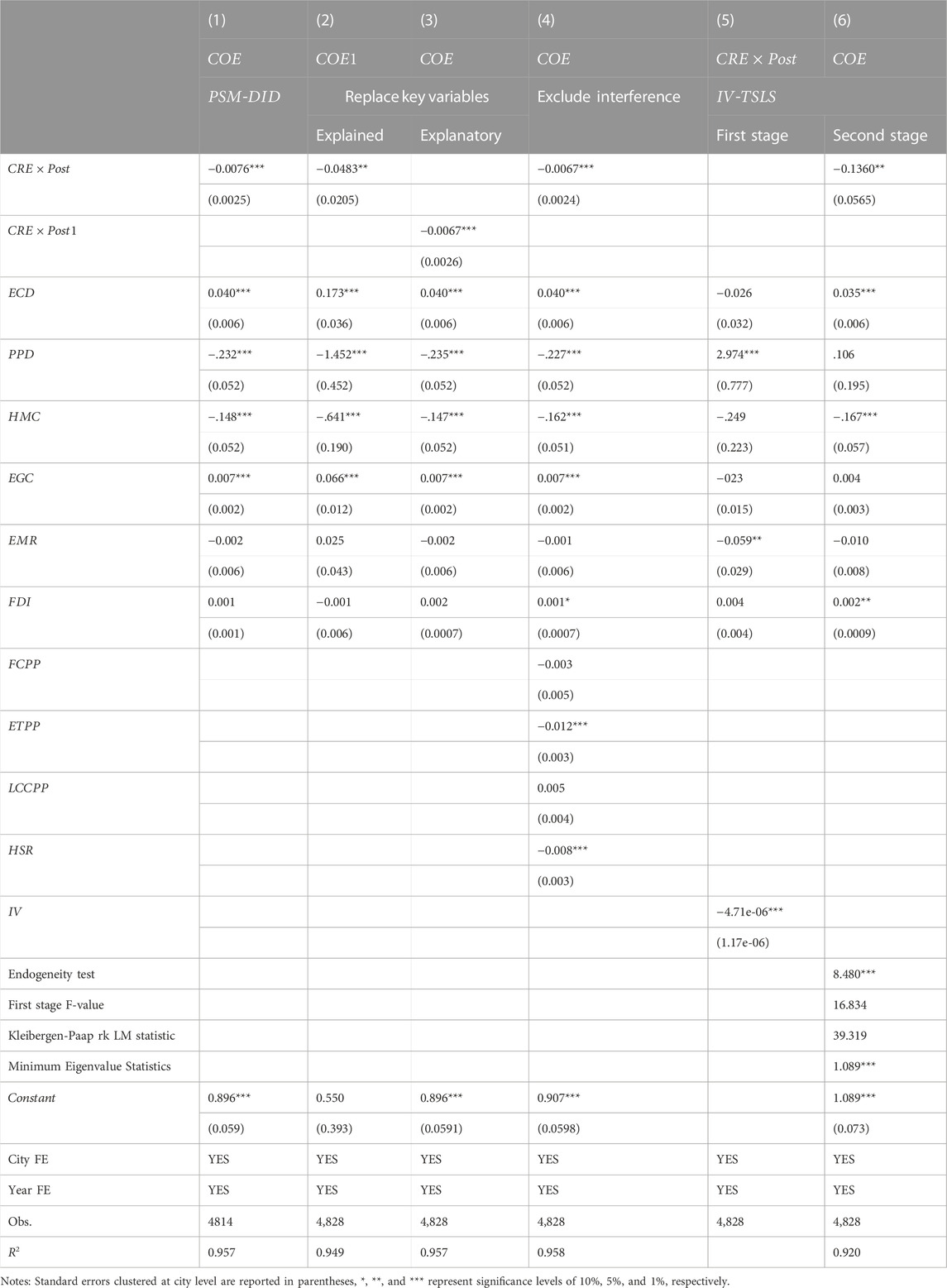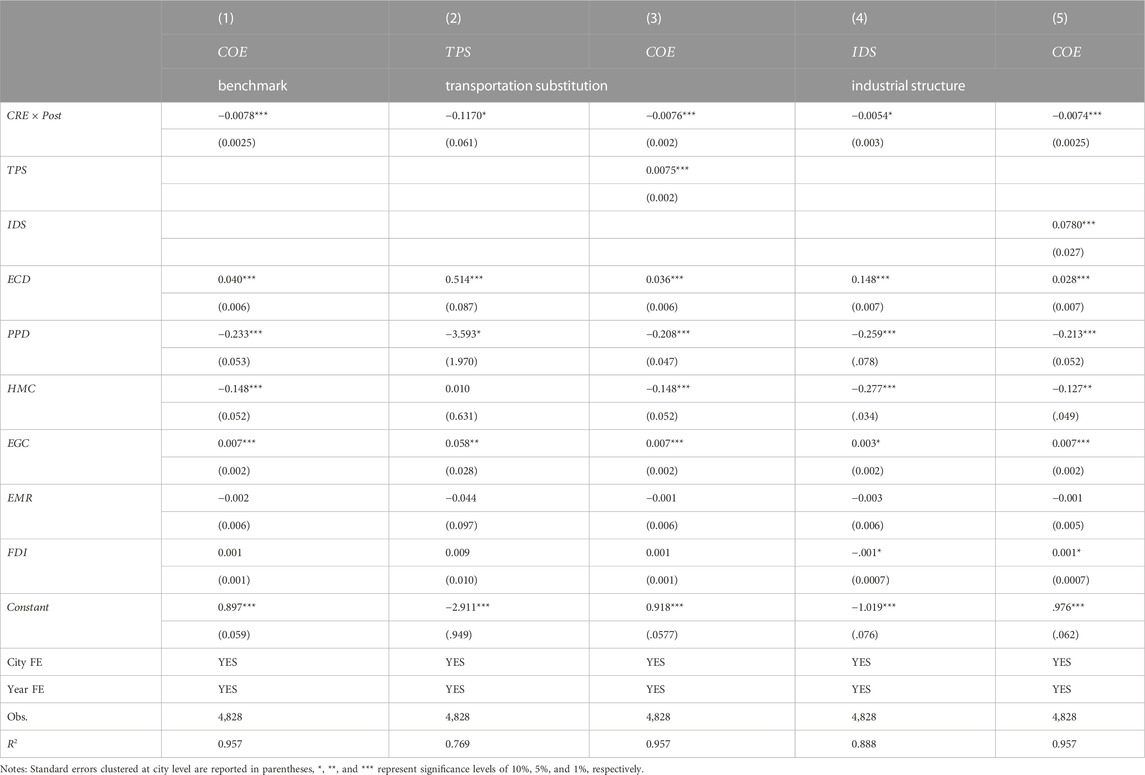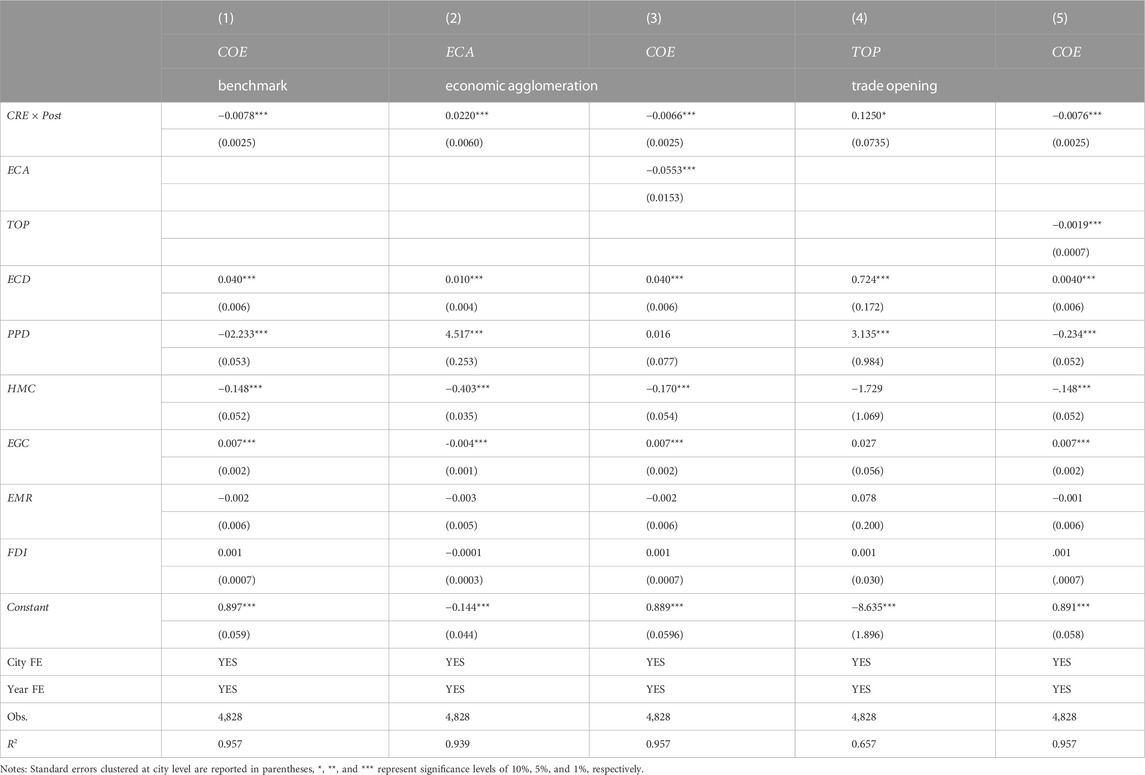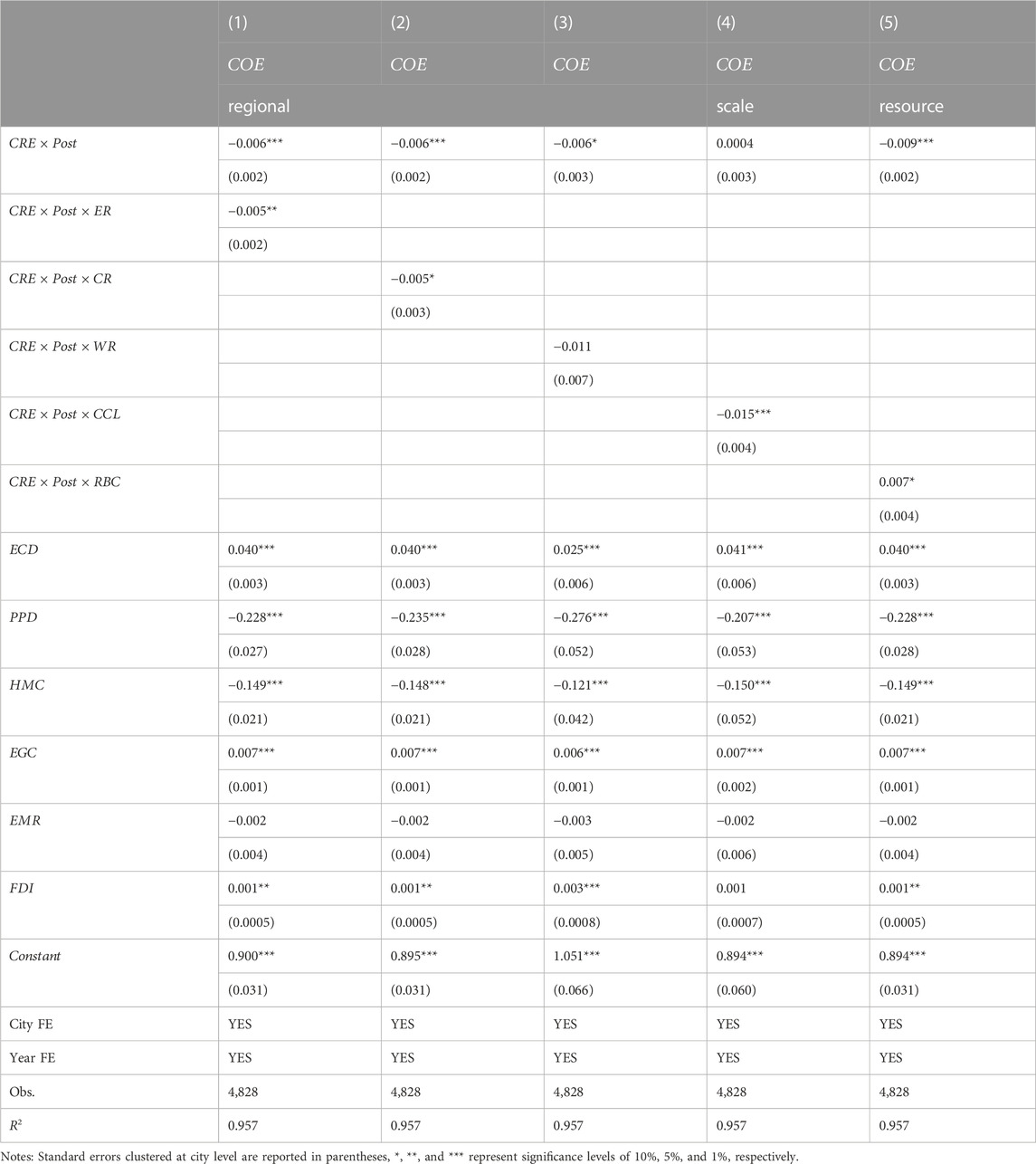- 1School of Economics and Management, Dongguan University of Technology, Dongguan, China
- 2Institute of Finance and Economics/School of Urban and Regional Sciences, Shanghai University of Finance and Economics, Shanghai, China
- 3School of Economics and Management, Jiangxi University of Science and Technology, Ganzhou, China
In the background of global “carbon neutrality,” China Railway Express (CRE) is contributing to the long-term development of low-carbon environmental protection while promoting economic growth. Based on panel data of 284 cities at the prefecture level and above in China from 2003 to 2019, we empirically investigate the impact and mechanism of CRE opening on urban carbon emissions using the multi-period DID model and mediating effect model. Under the assumption of meeting parallel trends, we find that the opening of CRE considerably lowers urban carbon emissions by .78 percentage points as compared to the control group. This finding holds after placebo testing, PSM-DID estimation, replacing key variables, excluding other policies and disturbances from the opening of the high-speed railway (HSR), and overcoming endogeneity problems. According to the findings of the mechanism tests, the influence of transportation substitution, improved industrial structure, economic agglomeration, and trade openness are crucial mechanisms for reducing carbon emissions by opening CRE. Further heterogeneity tests show that the carbon reduction effect of CRE opening is more pronounced in east-central China, larger and non-resource-based cities. Therefore, this study suggests that the Chinese government should pay attention to the positive effect of CRE on environmental protection. The government should accelerate the construction of comprehensive transportation infrastructure while rationalizing the layout of economic activities and population clustering.
1 Introduction
As the second largest economy in the world, China has been committed to addressing the issue of climate change and has set a series of carbon reduction targets and actions (Wang et al., 2020). At the 75th session of the United Nations General Assembly, Chinese President Xi Jinping emphasized that the government will work to achieve carbon peaking by 2030 and carbon neutrality by 2060. Notably, transportation is a significant source of greenhouse gas emissions, accounting for nearly one-third of the world’s total energy use (Jia et al., 2021). China Railway Express (CRE), one of the most environmentally friendly means of freight transportation, emits much fewer CO2 emissions than ocean, road, and air transportation under the same conditions, according to the Eurasian Railway Alliance Index (ERAI). It has been found that carbon emissions from China’s road, waterway, and air transport sectors have increased, while rail transport carbon emissions have decreased (Li et al., 2019). More importantly, Li et al. (2021a) found significant sectoral differences in China’s transportation carbon emissions in 2019. The share of railroad carbon emissions in total transportation carbon emissions is only .68%, much lower than the shares of carbon emissions from roads (86.76%), waterways (6.47%), and aviation (6.09%). According to China’s “CRE Development Report (2021)1,” the average carbon emissions of CRE are 1/15 of those of air transport and 1/7 of those of road transport. It has done an excellent job of setting an example when it comes to combating climate change and driving the advancement of environmentally friendly international transportation. As the initiator of the “Belt and Road,” China has taken the opening of CRE as a link to promote the interconnection of countries and node cities along the railway with China. With the development of CRE, it has also adapted to the green and sustainable development needs of the countries along the route, showing its strong vitality and development potential. Therefore, under the constraint of green and low-carbon development goals, the CRE operation status should not ignore the carbon emission issue (Yin et al., 2020). In the current context of China’s accelerated green transformation development, can the opening of CRE reduce carbon emissions? What mechanisms influence carbon emissions? We will conduct a methodical analysis at both the theoretical and empirical levels to provide normative answers to the two concerns mentioned above.
The carbon emission effect of CRE can be examined in terms of both transportation infrastructure and international trade openness since it is a new method of facilitating international trade. Transportation infrastructure specifically has an impact on carbon emissions through the transportation substitution effect, industrial structure effect, and economic agglomeration effect, among other mechanisms (Anderson, 2014; Xie et al., 2017; Shao et al., 2019a). Similar to HSR, CRE possesses the characteristics of transportation infrastructure and has the potential to significantly lower transportation costs. In addition to influencing industrial restructuring and the physical organization of regional economies, which both have an effect on urban carbon emissions, it can also replace non-rail freight traffic. On the other hand, international trade opening significantly affects carbon emissions, but there is a large difference between the impact of exports and imports on carbon emissions (Salman et al., 2019). In fact, CRE has the attributes of open international trade (Wang and Bu, 2019; Fang et al., 2020), and affects urban carbon emissions in the process of participating in export and import.
Studies on CRE have mostly focused on two elements. The operation of CRE has been studied from the perspectives of complex network analysis and transportation engineering in the first section. From a transportation engineering perspective, Jiang et al. (2018) examined the hinterland patterns of CRE and the types of product transportation and found that government subsidies reduced CRE transportation costs by 60%, while IT products tended to choose CRE transportation methods. Yin et al. (2020) found that carbon emissions, transportation costs, and transportation time have important effects on CRE operating plans, especially freight collection mode and transportation routes, but have less effect on operating frequency. From the perspective of complex network analysis, Zhang et al. (2020) used the structural hole indicator to examine the importance of nodes along the CRE network. He discovered that the nodes in China’s Guangzhou, Beihai, Quanzhou, Fuzhou, and Xiamen are quite significant. As a result, the nodes are important to multimodal transportation. Zhao et al. (2018) and Zhao et al. (2019) comprehensively evaluated the CRE network and empirically analyze the selection of consolidation centers and the optimization of routes.
According to some researchers, the second part of CRE opening might be seen as a sort of exogenous quasi-natural experiment. They then conducted an empirical analysis of the effects of CRE opening on economic and innovative activity using the Differences-in-Differences (DID) model. Wong et al. (2021) found that the opening of CRE boosted Chinese firms’ outbound investment and significantly improved the quality of urban economic growth; Li et al. (2022) found that CRE opening significantly increased urban total factor productivity through external effects and synergy effects, and there were significant positive spatial spillover effects; Li et al. (2021b) argued that CRE opening reduced factor transportation costs and attracted factor resource inflows, which in turn promoted industrial structure upgrading; Fang et al. (2020) confirmed the role of CRE opening in improving the openness of cities to international trade; Zhou and Zhang (2021) found that the opening of CRE effectively enhanced bilateral market attraction and reduced firms’ export costs, thus significantly boosting urban import and export growth. Wang and Bu (2019) considered CRE opening as an important manifestation of international trade activities that can increase export intensity and firm innovation level. Wei and Gu (2021) found that CRE opening can rationalize the flow and allocation of innovation factors, thus significantly improving urban innovation efficiency.
According to the above literature analysis, existing researchers have concentrated on the operational aspects of CRE and its effects on economic and innovation activities, but have not yet concentrated on its effects and mechanism on carbon emissions. We should not discount the possible effect of CRE opening on carbon emissions either, especially in light of the current state of global warming and China’s move to a green economy. As a Chinese-led policy arrangement for international land transport of goods and foreign trade cooperation, the opening of CRE is a typical quasi-natural experiment (Wong et al., 2021; Zhou and Zhang, 2021). In consideration of this, based on the panel data of 284 cities at the prefecture level and above in China from 2003 to 2019, we use the multi-period Difference-in-differences (DID) model and the mediating effect model to systematically examine the impact of CRE opening on urban carbon emissions and the mechanism of action. This study makes an effort to assess the mechanism behind CRE opening’s ability to reduce carbon emissions and offers support for China’s determination to pursue the climate goal of “peak carbon and carbon neutrality.”
The marginal contributions of this paper are mainly in the following three aspects. First, in the context of the Chinese government’s vigorous efforts in a low-carbon green economy, this paper for the first time constructs a research framework on CRE and CO2 emissions in terms of the transportation substitution effect, industrial structure effect, economic agglomeration effect, and trade opening effect, and proposes corresponding theoretical hypotheses, which enriches the research on transportation economy represented by CRE. In contrast to the existing studies that only focus on the economic and innovation effects of CRE opening, this paper focuses on the carbon emission reduction effects of CRE opening. Second, in a typical quasi-natural experiment, we treat the opening of CRE as a typical quasi-natural experiment and use the multi-period DID model and mediating effect model to accurately identify the causal relationship and transmission mechanism between CRE and carbon emissions. In addition, we conduct a series of robustness tests, such as the placebo test, PSM-DID estimation, and instrumental variables estimation, which provide reliable empirical support to test the theoretical hypotheses. Third, in terms of research depth, based on the perspectives of location conditions, scale, and resource endowment of Chinese cities, we further explore the heterogeneous effects of CRE opening on urban carbon emissions, providing reliable empirical evidence and rich policy insights for achieving high-quality development of CRE and low-carbon green economic development.
The next sections are organized as follows. Section 2 describes the transmission mechanism and formulates the theoretical hypotheses. Section 3 describes the research methodology and data description. Section 4 conducts the baseline empirical results and robustness analysis. Section 5 conducts the mechanism test and heterogeneity analysis. Section 6 describes the research conclusions and policy implications and discusses future research directions.
2 Policy background and mechanism analysis
2.1 Policy background
China urgently needs to strengthen its economic and trade cooperation ties with European nations in light of the expanding trade protectionism and COVID-19 epidemic, which has a negative influence on the global economy. Meanwhile, the Chinese government hopes to strengthen foreign economic partnerships through connected infrastructure (e.g., cross-border land transport links), thereby achieving the goal of high-quality economic openness for inland cities. In 2011, Chongqing City, China officially opened the “Chong (Chongqing) Xin (Xinjiang) Europe (European countries)” international freight train, according to a fixed schedule and route car, through the territory of Xinjiang Alashankou border crossing, Kazakhstan, Russia, Belarus, Poland, finally arrived in Duisburg, Germany. In each subsequent year, more and more cities in China have opened international freight trains, such as Suzhou, Wuhan, and Changsha in 2012, Dalian, Zhengzhou, Dongguan and Chengdu in 2013, Jinhua (Yiwu) and Hefei in 2014, Yingkou, Harbin, Xuzhou, Lianyungang, Xiamen, Nanchang, Linyi, Kunming and Lanzhou in 2015.
China’s National Development and Reform Commission and China Railway Corporation unified the brand of pre-operational international freight trains as CRE and jointly released the “China-European Express Construction and Development Plan (2016–2020)” to integrate the resources of international freight trains and create a well-known logistics brand with international competitiveness. CRE refers to the international railroad intermodal train running between China and European countries according to the fixed number of trains, routes, schedules, and full schedules. In April 2019, “the Joint Communique of the Roundtable Summit of the Second ‘Belt and Road’ International Cooperation Summit Forum” announced the establishment of the “Joint Working Group on CRE Transport,” and the guarantee mechanism related to the international operation of CRE is being continuously improved. The CRE has gradually become an important platform for the construction of “Belt and Road” and the realization of high-quality economic opening, and is planned to form a comprehensive cross-border transportation service system with reasonable layout, perfect facilities, stable capacity, convenient and efficient, safe and smooth by 2020.
CRE has operated as a new land-based commercial route and a new platform for international freight cooperation between Eurasia and the continent. CRE has increasingly come to know that two-way fully loaded commodities operate regularly to meet the development needs of China’s international trade. By the end of 2019, there are 58 additional Chinese cities where the CRE may have been established, up from 19 in 2015. There were 21,225 CREs as of 2019, representing an average yearly growth rate of 127%. The overall cost of the trains’ transportation dropped by roughly 40%, and their running time was reduced by about 30%. (Zhou and Zhang, 2021). In 2020, the transportation cost of CER is about 20% of that of air transportation, and the transportation time is about 25% of that of sea transportation. Additionally, it has the traits of being very stable and less susceptible to environmental change, which gives it comparative advantages in satisfying particular logistical objectives like high value and rapid timeliness. By the end of 2021, China will have connected 180 cities in at least 23 European nations by opening 91 cities with CREs.
Compared with traditionally relying mainly on sea transport for foreign trade, the opening of CRE, as a new way of organizing international land transport, provides a new choice of logistics for international trade between Asia and Europe. Meanwhile, it has adjusted the city’s cross-border trade transport mode. New global markets have been established, and the cost of shipping goods for trade between China and Europe has changed. This has changed not only the main means of transporting goods across international borders, but has also affected the modernization and upgrading of the industrial structure and industrial clustering. The openness of CRE has also sped up the progress of urban trade opening and significantly increased the level of trade facilitation and liberalization as one of the key forms of economic opening. Since CRE is a type of commercial opening and international land transportation, it has changed the city’s economic development and could affect the city’s low-carbon green development process.
2.2 Mechanism analysis
2.1.1 Transportation substitution effect
As a typical transportation infrastructure, CRE is a cross-border land transportation channel built under the leadership of the Chinese government and has similar characteristics of a public good as HSR. CRE is a transnational cargo transport agreement, a new framework for international cargo transport cooperation built on the existing railroad network, in contrast to HSR for passenger transport (Zhou and Zhang, 2021). CRE has a significant transportation cost advantage, as Jiang et al. (2018) found that the average shipping time from a Chinese central city to a Western European port city is four times longer than that of CRE transportation. In the background of global “carbon neutrality,” with its unique cost advantage and railroad network, CRE replaces the freight volume originally transported across the border by road, water and air. It also integrates “energy saving and emission reduction” into transportation. Especially for Chinese inland cities, the opening of CRE makes up for the inherent disadvantage of location, and allows goods and commodities to be transported directly across the border. It reduces the transit process of other types and enables the gradual transformation of the local low-carbon economy.
Whether rail transportation is low-carbon is a topic of academic debate. For example, Liu et al. (2015a) compared the carbon emissions of each transportation mode in China in 2012. He found that CO2 emissions from roads, waterways, and air reached 65.21%, 29.07%, and 3.61%, respectively, while CO2 emissions from railroad transportation accounted for only 2.11%. Meanwhile, Li et al. (2021) also found that the share of railroad carbon emissions in total transportation carbon emissions in China in 2019 was only .68%, much lower than the share of carbon emissions from roads (86.76%), waterways (6.47%), and aviation (6.09%). In addition, Li et al. (2019) found that transportation carbon emissions from roads, waterways, and aviation in China have increased, while rail transportation carbon emissions have decreased, with roads being the main source of transportation carbon emissions growth in China. It can be seen that railroads play an important role in reducing overall greenhouse gas emissions. It is more environmentally friendly than other modes of transportation. (Baker et al., 2010). As a result, rail has emerged as the alternative for moving freight that is least harmful to the environment. It has significantly decreased direct carbon emissions thanks to the rise in freight orders from the CRE. This means that when CRE opens, the drop in non-rail freight also means a significant drop in carbon emissions. In conclusion, we believe that CRE opening reduces urban carbon emissions through the transportation substitution effect.
2.2.2 Industrial structure effect
As a cross-border land transportation channel and international trade cooperation mechanism, CRE compresses time and space costs, and influences industrial structure adjustment. The theory of new economic geography states that CRE encourages the development of the opening city to take advantage of the core region’s comparative advantage by lowering the cost of factor transportation and luring in new sources of factor resources. It also encourages the improvement of the industrial structure under the influence of circular accumulation (Li et al., 2021b). The industrial structure has been improved and developed in the direction of services at this time, and services like transportation, wholesale and retail, and business services—all of which are directly tied to CRE—have developed quickly. Therefore, CRE promotes the transformation and upgrading of industrial structure with liner transportation and deepens bilateral industrial cooperation. Then it promotes international production capacity cooperation, promotes trade and investment integration, and realizes the reform goal of industrial upgrading and optimization.
Furthermore, industrial structure adjustment is a key factor in carbon emissions. The consumption of energy and natural resources decreases along with the proportion of the industry, which in turn lowers carbon emissions. High-energy and high-pollution businesses are gradually removed and transformed as China’s regional economic development, green technology levels, and environmental legislation advance, and industrial restructuring aids in hastening the attainment of China’s carbon emission intensity targets. Zhang et al. (2018) found that carbon emission reductions due to the restructuring of the three major industries in China accounted for 28.22% of the total national carbon emission reductions. There is a significant difference in the contribution of different industrial sectors to carbon emission reduction, with the structural transformation of agriculture and industry playing a positive role in carbon emission reduction. Combined with the region’s industrial advantages, high-value-added and low-pollution services have been developed rapidly, gradually replacing high-pollution industries, thereby reducing pollution emissions (He et al., 2018). In addition, the focus of industrial restructuring is to enhance the added value of products, thereby reducing energy consumption and carbon emission intensity per unit of added value. The increase in the added value of products mainly relies on the development of the producer service industry, which can reduce the production cost of the manufacturing industry, and extend the industrial value chain. It also reduces carbon emissions in the process of promoting the transformation and upgrading of the manufacturing structure (Han and Xie, 2017). In conclusion, we think that the CRE’s opening will encourage the modernization of industrial infrastructure and thus lower urban carbon emissions.
2.2.3 Economic agglomeration effect
According to the new economic geography, the combination of market size, cross-regional factor flows, and transportation costs determine the concentration of regional economic activities under monopolistic competition (Krugman, 1980; Krugman, 1991). Transportation infrastructure has been shown to lower transportation costs, improve the availability of goods, capital, labor, and other elements, and alter the geographic distribution of economic activities (Donaldson and Hornbeck, 2016; Ahlfeldt and Feddersen, 2018). CRE development must take into account elements like cheap cost and the city’s need for global commodity trading as a new kind of international land transportation. It has a significant influence on where industrial and service firms choose to locate. Relying on cross-border rail networks, the opening of CRE has effectively expanded market boundaries, greatly reduced transportation costs, enhanced the accessibility of goods, and thus changed the economic quality and agglomeration of cities in time and space (Wong et al., 2021). In addition, CRE connects Asia-Europe transportation routes, making the economic gathering and radiation function along the routes stronger and stronger. CRE not only brings convenience and benefits to the people of each country, but also injects new vitality into the development of enterprises and industries in the countries along the routes.
Higher economic density leads to stronger spillover effects of sharing, matching, and learning from agglomeration economies in areas with higher levels of economic agglomeration (Ingstrup and Damgaard, 2013). This leads to an efficient allocation of resources, resulting in higher utilization of human capital and equipment and emission reduction effects. The massive agglomeration of production factors creates conditions for energy saving and emission reduction. On the one hand, the positive externalities and economies of scale of economic agglomeration are increasingly prominent. They are conducive to accelerating technological change and exchange, generating green technology spillover effects, and prompting enterprises to improve their energy-saving and emission-reduction performance. For example, the degree of energy-saving and emission reduction in urban areas with higher economic agglomeration is higher than that in rural areas with lower agglomeration (Glaeser and Kahn, 2010). On the other hand, economic agglomeration facilitates unified environmental management by government agencies and reduces the cost of government environmental regulation of enterprises. It promotes the development of agglomeration of professional environmental protection enterprises, and thus limits the growth of carbon emissions (Han et al., 2018; Shao et al., 2019a). In addition, Yu et al. (2020) empirically showed that urban agglomeration activities significantly reduced carbon emissions, i.e., for every 1% increase in urban population, carbon emissions would be reduced by .22%. Thus, CRE opening promotes economic agglomeration, which in turn leads to carbon reduction.
2.2.4 Trade opening effect
The CRE is a new international land transportation corridor that opens up new opportunities for cross-border freight collaboration on the Eurasian continent and considerably boosts the development of commodity import and export in Chinese cities (Zhou and Zhang, 2021). To promote trade facilitation and increase the gravitational pull of the bilateral market, CRE discovered the need for “point-to-point” transit between opening cities and destination nations. Compared with road, air, and sea, CRE has the advantages of low-cost and stable transportation, which attracts a large number of cross-border commodities and cargoes. CRE can reduce the uncertainty in transit and maximize trade convenience, to attract a large number of cross-border goods and sources. Fang et al. (2020) found that the opening of CRE would significantly reduce trade costs, unleash the effect of scale economies and external economies in related industries, and improve the competitiveness of export products and expand demand for imported products, thereby expanding the degree of trade openness.
The impact of international trade opening on carbon emissions is complex and two-sided (Shahbaz et al., 2017). On the one hand, increased exports result in higher domestic output, which uses a lot of energy, fossil fuels, and other natural resources and increases carbon emissions (Bosupeng, 2016). On the other side, as imports increase, the manufacturing of domestic products is replaced, which results in a decrease in the resources and energy used in production and a consequent reduction in carbon emissions. Long et al. (2018) found that China’s embodied carbon emissions in exports reached 2318.73 Mt in 2014 compared to 2000, much higher than the 757 Mt of embodied carbon emissions in imports in the same period. This indicates that China was a typical net exporter of embodied carbon. Meanwhile, the expansion of imports has also brought knowledge and technology spillover, prompting domestic enterprises to transform technology and improve production efficiency, and achieve cleaner production (Kozul-Wright and Fortunato, 2012). In addition, Yang et al. (2018) argue that import activities introduce advanced technologies and equipment that contribute to the gradual improvement of labor productivity and resource use efficiency, while the import of resources and energy relieves production pressure, thus reducing carbon emissions in the long run. If the import is more open than the export, trade opening can lower carbon emissions, and vice versa, it can increase carbon emissions. As a result, we think that expanding CRE can increase trade openness, which in turn influences urban carbon emissions.
Figure 1 illustrates the relationship among all the mechanisms. Based on the above mechanism analysis, we propose the following two theoretical hypotheses:
3 Methodology and data
3.1 Econometric model
Referring to Li et al. (2021c) and Wong et al. (2021), we take the opening of CRE as a quasi-natural experiment, and empirically investigate the impact of the opening of CRE on urban carbon emissions by using the multi-period DID model. The econometric model is as follows.
where
3.2 Variable definition
3.2.1 Explained variable
The explained variable
3.2.2 Explanatory variable
The explanatory variable
3.2.3 Control variables
Economic development (
Population density (
Human Capital (
Energy consumption (
Environmental regulation (
Foreign investment (
3.2.4 Mediator variables
Transportation alternatives
Industry structure (
Economic Agglomeration (
Trade opening (
3.3 Data description
We take 284 cities at the prefecture level and above in China from 2003 to 2019 as the study object. For urban carbon emission data measurement, we first calibrate two sets of satellite nighttime light data, DMSP/OLS and VIIRS, by drawing on Elvidge et al. (2017), to obtain the Chinese nighttime light datasets. Then, drawing on Shan et al. (2018), we calculate China’s provincial CO2 emissions. Lastly, based on the significant positive correlation between nighttime lighting data and carbon emissions (Wang et al., 2017), we applied the top-down method to measure the carbon emissions in Chinese cities from 2003 to 2019. Besides, the data related to the opening of CRE is obtained from the official website of China Railway Corporation2, China State Railway Container Transportation Corporation3, “Belt and Road”4, local railroad bureaus, and other major official websites, etc. Except for the CO2 emission data and CRE data, all other data used in this study are obtained from the 2004–2020 China City Statistical Yearbook5, China City Construction Statistical Yearbook, and the statistical yearbooks of each province. The descriptive statistical characteristics of the variables are shown in Table 1.
4 Benchmark results and analysis
4.1 Parallel trend test
It should be noted that the validity of the DID estimation results exists on the prerequisite, which the treatment and control groups should satisfy the parallel trend assumption. Referring to Beck et al. (2010), we empirically test the parallel trend hypothesis by the event study method. The empirical model is as follows.
where
From Figure 2, the estimated coefficients of
4.2 Analysis of benchmark regression result
We empirically estimate model (1), and the regression results are reported in Table 2. The column (1) does not control for city-fixed effects and time-fixed effects, and columns (2)–(5) control for city-fixed effects and time-fixed effects. The coefficient for
In terms of control variables, the estimation results are consistent with theoretical expectations. Economic development
4.3 Robust test
4.3.1 Placebo test
Drawing on Chetty et al. (2009) and Li et al. (2016), we used a placebo test to ensure the robustness of the benchmark result. First, we randomly generate a list of CRE-opened cities and assign the corresponding opening years, thus forming a sample of errors. Then, based on the benchmark model (1), we empirically estimate the above false sample using the DID method, leading to a false estimation coefficient
4.3.2 PSM-DID method
There is another prerequisite for the DID estimation method, which is that the selection of CRE opening cities needs to be random. To exclude the interference of sample selection problem, referring to Jia et al. (2021) and Yang et al. (2019), we apply Propensity Score Matching (PSM) method to re-screen the control group and perform DID estimation on the matched samples. First, given that cities open CRE at different times, we use the year-by-year matching method, and use control variables in model (1) as matching characteristic covariates. We then use nearest neighbor matching method to construct control groups for CRE opening cities, and estimate it by using the Logit model and estimate the corresponding propensity scores.
To ensure the validity of the matching results, we perform a balance test. Table 3 shows that each characteristic covariates is significantly different at the 1% level before matching, while there is no significant difference after matching. Therefore, it is reasonable to believe that the matched covariates are appropriate and the results of the nearest neighbor matching method are reliable.
Finally, the results in column (1) of Table 4 are obtained with the support of the PSM-DID method. The estimated coefficient of the matched
4.3.3 Replace key variables
In this section, we change the measures of carbon emissions and CRE opening variables, and re-estimate the empirical result. For the explanatory variables, drawing on Shan et al. (2020) and Guan et al. (2021), we use urban carbon emission data published by the China Carbon Accounting Database (Carbon Emission Accounts and Datasets, CEADs) for the measurement. For the explanatory variables, we no longer distinguish the cut-off point of the opening time, June, but assign a value of 1 to the year of opening and thereafter, and 0 to the rest of the year. At this moment, we could obtain the new CRE opening variable (
4.3.4 Exclude the interference from other policies and HSR
Some pilot policies on carbon emissions and the opening of HSR may also affect the baseline results (Jia et al., 2021; Sun and Li, 2021). To avoid the interference of other policies and the opening of HSR, we collect some disturbing factors, such as the Fiscal Comprehensive Pilot Policy (FCPP) for energy conservation and emission reduction, Emissions Trading Pilot Policy (ETPP), Low Carbon City Pilot Policy (LCCPP), and the opening of HSR. Then, we include the above-mentioned confounding factors into model (1) for estimation, and the results are reported in column (4) of Table 4. At this point, we find that the coefficient of
4.3.5 Overcome endogenous problems
The endogeneity problem in this paper arises mainly from the non-random nature of sample selection for the opening of CRE. To further overcome the potential endogeneity problem, we construct an instrument variable and use the method of Two-stage Least Squares (TSLS) to estimate. The corresponding results are reported in columns (5)–(6) of Table 4.
Specifically, referring to Jiang et al. (2018), we use the shortest geographic distance from each city to China’s three major corridor ports (Alataw Pass, Erlianhaote and Manzhouli) of the CRE as the instrumental variable (IV). In order to realize the dynamic change of the instrumental variable, following Nunn and Qian (2014), we use the product of the above shortest geographic distance and the national railroad freight volume in the previous year to construct a time-varying instrumental variable. Then, in terms of the rationality of IV, on the one hand, the above three continental border crossings are closely related to the ancient Silk Road and the CRE operation channel, and the closer the distance to the crossings, the more competitive the location characteristics and operation costs are. Then, those cities are more likely to open CRE, thus satisfying the correlation requirement. On the other hand, geographical distance is a typical natural factor, not affected by economic and social factors, and can only affect the carbon emission status by influencing the CRE opening status (such as transportation distance and time cost, etc.). Meanwhile, the rail freight volume at the national level in the previous year is independent of the carbon emission of each city in the current period, so the requirement of exogeneity is satisfied.
As shown in columns (5)–(6) of Table 4, the first stage results show that the estimated coefficient of IV is significantly negative at the 1% statistical level, indicating that there is a significant negative correlation between IV and the opening of CRE, which is in line with theoretical expectations. The second stage results show that the endogeneity test results strongly reject the null hypothesis that
5 Mechanism test and heterogeneity analysis
5.1 Mechanism test
5.1.1 Mediation effect model
In order to confirm the mechanism, referring to Baron and Kenny (1986), we construct a three-step mediating effect model for mechanism testing. The model is as follows.
where
5.1.2 The results of mechanism test
Based on the models (3)–(5), we report the results of the mechanism tests in Tables 5; Table 6, where column (1) is the baseline estimation result. For transport substitution
For industrial structure
For economic agglomeration
For trade opening
In summary, we find that the opening of CRE reduces urban carbon emissions through four mechanisms: exerting the transportation substitution effect, promoting industrial structure upgrading, strengthening economic agglomeration, and promoting trade opening. Therefore, the estimation results of the mediating effects model validate the second theoretical hypothesis of this paper.
5.2 Heterogeneity analysis
5.2.3 Regional heterogeneity
Referring to Sun and Li (2021), we divide the provinces where the sample cities are located into three major regions, and then construct three location dummy variables for whether the cities are in the eastern region
5.2.4 Scale heterogeneity
Based on the 2019 China City Level, we construct the China city level
5.2.3 Resource endowment heterogeneity
Based on the National List of Resource-based Cities published by the State Council of China, we construct the resource-based cities
6 Conclusion and discussion
In order to verify the carbon emission effect and mechanism of CRE opening, we conduct a systematic theoretical analysis and empirical study. Based on panel data of 284 cities at the prefecture level and above in China from 2003 to 2019, we empirically examine the impact and mechanisms of CRE opening on carbon emissions by the multi-period DID model and the mediating effect model. To ensure the robustness and richness of the empirical results, a series of robustness tests and heterogeneity discussions are conducted. The main findings are as follows.
First, under the premise of satisfying parallel trends, the opening of CRE significantly reduces urban carbon emissions by .78 percentage when compared to the control group. This finding holds after placebo test, PSM-DID estimation, replacing key variables, excluding the interference from other policy and HSR, and overcoming endogeneity issues. Second, the results of the mediating effect model indicate that CRE opening reduces urban carbon emissions through four channels: transportation substitution effect, industrial structure upgrading, economic agglomeration effect and promoting trade opening. Third, the carbon emission effect of CRE opening has typical heterogeneous characteristics. The opening of CRE significantly suppresses carbon emissions of cities in east-central China, larger scale and non-resource-based cities, but the effect on carbon emissions of western cities is not significant.
Combined with the empirical results of this paper, we discuss the policy from the following three aspects. First, Chinese government should pay attention to the positive role of CRE in environmental protection. Government should take into account the cities’ own location, economic and resource advantages, reasonably lay out the CRE network. Also, government should focus on promoting the opening of CRE in western, small cities and resource-based cities, so as to fully release the carbon emission reduction effect. We find that the opening of CRE can significantly reduce the carbon emission, especially in east-central China, larger scale and non-resource-based cities. Then, Chinese government should accelerate the construction of integrated transportation infrastructure such as roads, railroads, waterways and airways. Government should promote the upgrading of industrial structure and adhere to a high level of economic opening policy to achieve an effective and balanced economic agglomeration, so as to effectively curb the growth of carbon emissions. We find that transportation substitution, industrial structure upgrading, trade opening and economic agglomeration are important transmission mechanisms for the opening of CRE to achieve carbon emission reduction. Finally, the government should also rationalize the layout of economic activities and population clusters, promote human capital accumulation, setting reasonable environmental regulations, and adhere to the development strategy of implementing energy conservation and emission reduction. We also find that economic development and energy consumption significantly increase carbon emissions, while population density, human capital and environmental regulations help to reduce carbon emissions.
As a typical transportation infrastructure, CRE is a cross-border land transportation led by the Chinese government and is a new mechanism for international cargo transport cooperation on the established railroad network (Zhou and Zhang, 2021). Meanwhile, the 2021 CRE Development Report points out that CRE has become a major approach for China to participate in global economic cooperation, build the “Belt and Road” initiative and promote the building of a human community with a shared future. The Chinese government will strive to reach Carbon Peaking by 2030 and Carbon Neutrality by 2060. According to the Eurasian Railway Alliance Index (ERAI), CRE has much lower CO2 emissions than other types of transportation. CRE is one of the most environment-friendly types of freight transport. Therefore, while meeting the needs of economic cooperation between China and the Asian and European countries, the Chinese government always adheres to the concept of green, low-carbon, recycling and sustainable development, and accelerates the low-carbon and green development of the operation of CRE. Undoubtedly, the results of this study directly reveal that the operation of CRE in Chinese cities can effectively reduce carbon emissions, further enriching the research on the relationship between transportation and carbon emissions. We provide Chinese experience for the realization of low-carbon green economic development for the majority of developing countries.
Finally, this study still has certain shortcomings and still needs further in-depth study. Later studies can also combine spatial econometrics and use spatial DID models to empirically test the spatial spillover effects of CRE opening on carbon emissions. In addition, we only consider the impact of CRE opening on carbon emissions in domestic cities, without considering its impact on carbon emissions or environmental quality in the pathway countries. Therefore, subsequent studies can also further explore the impact and mechanism of CRE opening on the environmental quality of the route countries from a cross-country perspective, and compare the differences in the impact of CRE opening on the environmental quality of China and the route countries.
Data availability statement
The original contributions presented in the study are included in the article/Supplementary Material, further inquiries can be directed to the corresponding author.
Author contributions
ZQ: Conceptualization, Methodology, Resources, Formal Analysis, Writing (Original Draft), Funding Acquisition; DL: Conceptualization, Writing (Original Draft), Writing (Review and Editing); QL: Investigation, Supervision, Writing (Review and Editing), Funding Acquisition. All authors read and approved the manuscript.
Funding
This work was supported by the Postgraduate Innovation Fund Project of Shanghai University of Finance and Economics under Grant (CXJJ-2020-306) and National Social Science Foundation of China (Grant No. 21BGL182).
Conflict of interest
The authors declare that the research was conducted in the absence of any commercial or financial relationships that could be construed as a potential conflict of interest.
Publisher’s note
All claims expressed in this article are solely those of the authors and do not necessarily represent those of their affiliated organizations, or those of the publisher, the editors and the reviewers. Any product that may be evaluated in this article, or claim that may be made by its manufacturer, is not guaranteed or endorsed by the publisher.
Footnotes
1https://www.ndrc.gov.cn/fzggw/jgsj/kfs/sjdt/202208/P020220818311703111697.pdf.
2http://www.china-railway.com.cn/zyyw/hwys/.
3https://www.crct.com/index.php?m=content&c=index&a=lists&catid=22#gjly.
4China Railway Container Corporation website: https://www.yidaiyilu.gov.cn/yw/qwfb/4802.html.
5https://data.cnki.net/Yearbook/Single/N2022040095.
References
Ahlfeldt, G. M., and Feddersen, A. (2018). From periphery to core: Measuring agglomeration effects using high-speed rail. J. Econ. Geogr. 18 (2), 355–390. doi:10.1093/jeg/lbx005
Anderson, M. L. (2014). Subways, strikes, and slowdowns: The impacts of public transit on traffic congestion. Am. Econ. Rev. 104 (9), 2763–2796. doi:10.1257/aer.104.9.2763
Baker, C. J., Chapman, L., Quinn, A., and Dobney, K. (2010). Climate change and the railway industry: A review. J. Mech. Eng. Sci. 224 (3), 519–528. doi:10.1243/09544062jmes1558
Baron, R. M., and Kenny, D. A. (1986). The moderator-mediator variable distinction in social psychological research: Conceptual, strategic, and statistical considerations. J. personality Soc. Psychol. 51 (6), 1173–1182. doi:10.1037/0022-3514.51.6.1173
Beck, T., Levine, R., and Levkov, A. (2010). Big bad banks? The winners and losers from bank deregulation in the United States. J. Finance 65 (5), 1637–1667. doi:10.1111/j.1540-6261.2010.01589.x
Bosupeng, M. (2016). The effect of exports on carbon dioxide emissions: Policy implications. Int. J. Manag. Econ. 51 (1), 20–32. doi:10.1515/ijme-2016-0017
Chetty, R., Looney, A., and Kroft, K. (2009). Salience and taxation: Theory and evidence. Am. Econ. Rev. 99 (4), 1145–1177. doi:10.1257/aer.99.4.1145
Combes, P. P., Duranton, G., and Gobillon, L. (2007). Spatial wage disparities: Sorting matters!. J. Urban Econ. 63 (2), 723–742. doi:10.1016/j.jue.2007.04.004
Donaldson, D., and Hornbeck, R. (2016). Railroads and American economic growth: A "market access" approach. Q. J. Econ. 131 (2), 799–858. doi:10.1093/qje/qjw002
Duranton, M., and Turner, M. (2012). Urban Growth and Transportation[J]. Rev. Econ. Stud. 79 (4), 1407–1447. doi:10.1093/restud/rds010
Elvidge, C. D., Baugh, K., Zhizhin, M., Hsu, F. C., and Ghosh, T. (2017). VIIRS night-time lights. Int. J. Remote Sense 38, 5860–5879. doi:10.1080/01431161.2017.1342050
Fang, X. M., Lu, Y. X., and Wei, J. (2020). The impact of China railway express on the openness of China’s urban trade: Based on the perspective of the belt and road construction. Int. Trade Econ. Res. 36 (2), 39–55. doi:10.13687/j.cnki.gjjmts.20200218.001
Friedrichs, J., and Inderwildi, O. R. (2013). The carbon curse: Are fuel rich countries doomed to high CO2 intensities? Energy Policy 62, 1356–1365. doi:10.1016/j.enpol.2013.07.076
Glaeser, E. L., and Kahn, M. E. (2010). The greenness of cities: Carbon dioxide emissions and urban development. J. Urban Econ. 67 (3), 404–418. doi:10.1016/j.jue.2009.11.006
Guan, Y. R., Shan, Y. L., Huang, Q., Chen, H., Wang, D., and Hubacek, K. (2021). Assessment to China’s recent emission pattern shifts. Earth’s Future 9 (11), 1–13. doi:10.1029/2021ef002241
Han, F., Xie, R., Lu, Y., Fang, J., and Liu, Y. (2018). The effects of urban agglomeration economies on carbon emissions: Evidence from Chinese cities. J. Clean. Prod. 172 (1), 1096–1110. doi:10.1016/j.jclepro.2017.09.273
Han, F., and Xie, R. (2017). Has the agglomeration of producer service industries reduced carbon emissions? —a spatial measurement analysis of panel data of cities at prefecture-level and above in China. Quantitative Econ. Tech. Econ. Res. 34 (3), 40–58. doi:10.13653/j.cnki.jqte.2017.03.003
He, W., Wang, B., and DanishWang, Z. (2018). Will regional economic integration influence carbon dioxide marginal abatement costs? Evidence from Chinese panel data. Energy Econ. 74, 263–274. doi:10.1016/j.eneco.2018.06.010
Ingstrup, M. B., and Damgaard, T. (2013). Cluster facilitation from a cluster life cycle perspective. Eur. Plan. Stud. 21 (4), 556–574. doi:10.1080/09654313.2012.722953
Jia, R., Shao, S., and Yang, L. (2021). High-speed rail and CO2 emissions in urban China: A spatial difference-in- differences approach. Energy Econ. 99, 105271. doi:10.1016/j.eneco.2021.105271
Jiang, Y. L., Sheu, J. B., Penga, Z. X., and Yu, B. (2018). Hinterland patterns of China railway (CR) express in China under the belt and road initiative: A preliminary analysis. Transp. Res. Part E 119, 189–201. doi:10.1016/j.tre.2018.10.002
Kozul-Wright, R., and Fortunato, P. (2012). International trade and carbon emissions. Eur. J. Dev. Res. 24 (4), 509–529. doi:10.1057/ejdr.2012.15
Krugman, P. (1980). Scale economies, product differentiation, and the pattern of trade. Am. Econ. Rev. 70 (5), 950–959.
Krugman, P. (1991). Increasing returns and economic geography. J. Political Econ. 99, 483–499. doi:10.1086/261763
Li, P., Lu, Y., and Wang, J. (2016). Does flattening government improve economic performance? Evidence from China. J. Dev. Econ. 123 (123), 18–37. doi:10.1016/j.jdeveco.2016.07.002
Li, F. Y., Cai, B. F., Ye, Z. Y., Wang, Z., Zhang, W., Zhou, P., et al. (2019). Changing patterns and determinants of transportation carbon emissions in Chinese cities. Energy 174, 562–575. doi:10.1016/j.energy.2019.02.179
Li, X. Y., Tan, X. Y., Wu, R., Xu, H., Zhong, Z., Li, Y., et al. (2021a). Paths for carbon peak and carbon neutrality in transport sector in China. Strategic Study CAE 23 (6), 15–21. doi:10.15302/j-sscae-2021.06.008
Li, J., Min, Y., and Wang, X. (2021b). Launching the CR express and industrial upgrading: Research based on a quasi-natural experiment of 285 prefecture-level cities in China. Industrial Econ. Res. 3, 69–83. doi:10.13269/j.cnki.ier.2021.03.006
Li, J., Hu, J., and Yang, L. (2021c). Can trade facilitation prevent the formation of zombie firms? Evidence from the China railway express. China World Econ. 29 (1), 130–151. doi:10.1111/cwe.12366
Li, C., Zhang, J., and Lyu, Y. (2022). Does the opening of China railway express promote urban total factor productivity? New evidence based on SDID and SDDD model. Socio-Economic Plan. Sci. 80 (3), 101269. doi:10.1016/j.seps.2022.101269
Liu, Z., Li, L., and Zhang, Y. J. (2015a). Investigating the CO2 emission differences among China’s transport sectors and their influencing factors. Nat. Hazards 77 (2), 1323–1343. doi:10.1007/s11069-015-1657-2
Liu, Z., Guan, D., Wei, W., Davis, S. J., Ciais, P., Bai, J., et al. (2015b). Reduced carbon emission estimates from fossil fuel combustion and cement production in China. Nature 524, 335–338. doi:10.1038/nature14677
Long, R. Y., Li, J. Q., Chen, H., Zhang, L., and Li, Q. (2018). Embodied carbon dioxide flow in international trade: A comparative analysis based on China and Japan. J. Environ. Manag. 209, 371–381. doi:10.1016/j.jenvman.2017.12.067
Meng, L. W., Graus, E., Worrell, H. B., and Huang, B. (2014). Estimating CO2 emissions at urban scales by DMSP/OLS nighttime light imagery: Methodological challenges and a case study for China. Energy 71 (4), 468–478. doi:10.1016/j.energy.2014.04.103
Nunn, N., and Qian, N. (2014). US food aid and civil conflict[J]. Am. Econ. Rev. 104 (6), 1630–1666. doi:10.1257/aer.104.6.1630
Salman, M., Long, X., Dauda, L., Mensah, C. N., and Muhammad, S. (2019). Different impacts of export and import on carbon emissions across 7 asean countries: A panel quantile regression approach. Sci. Total Environ. 686, 1019–1029. doi:10.1016/j.scitotenv.2019.06.019
Shahbaz, M., Nasreen, S., Ahmed, K., and Hammoudeh, S. (2017). Trade openness-carbon emissions nexus: The importance of turning points of trade openness for country panels. Energy Econ. 61 (1), 221–232. doi:10.1016/j.eneco.2016.11.008
Shan, Y. L., Guan, D. B., Hubacek, K., Zheng, B., Davis, S. J., Jia, L., et al. (2018). City-level climate change mitigation in China. Sci. Adv. 4 (6), eaaq0390. doi:10.1126/sciadv.aaq0390
Shan, Y., Huang, Q., Guan, D., and Hubacek, K. (2020). China CO2 emission accounts 2016-2017. Sci. Data 7, 54. doi:10.1038/s41597-020-0393-y
Shao, S., Yang, L. L., Yu, M. B., and Yu, M. L. (2011). Estimation, characteristics, and determinants of energy-related industrial CO2 emissions in Shanghai (China), 1994-2009. Energy Policy 39 (10), 6476–6494. doi:10.1016/j.enpol.2011.07.049
Shao, S., Zhang, K., and Dou, J. (2019a). The energy saving and emission reduction effects of economic agglomeration: Theory and Chinese experience. J. Manag. World 1, 36–60. doi:10.19744/j.cnki.11-1235/f.2019.0005
Shao, S., Chen, Y., Li, K., and Yang, L. (2019b). Market segmentation and urban CO2 emissions in China: Evidence from the yangtze river delta region. J. Environ. Manag. 248, 109324. doi:10.1016/j.jenvman.2019.109324
Song, M., Guo, X., Wu, K., and Wang, G. (2015). Driving effect analysis of energy-consumption carbon emissions in the Yangtze River Delta region. J. Clean. Prod. 103, 620–628. doi:10.1016/j.jclepro.2014.05.095
Stock, J., and Yogo, M. Testing for weak Instruments in liner IV regression [C]. NBER Working Paper No. T0284, 2002.
Sun, L., and Li, W. (2021). Has the opening of high-speed rail reduced urban carbon emissions? —empirical analysis based on panel data of cities in China. J. Clean. Prod. 321 (2), 128958. doi:10.1016/j.jclepro.2021.128958
Verhoef, E. T., and Nijkamp, P. (2002). Externalities in urban sustainability: Environmental versus localization-type agglomeration externalities in a general spatial equilibrium model of a single-sector monocentric industrial city. Ecol. Econ. 40 (2), 157–179. doi:10.1016/s0921-8009(01)00253-1
Wang, F., Shackman, J., and Liu, X. (2017). Carbon emission flow in the power industry and provincial CO 2 emissions: Evidence from cross-provincial secondary energy trading in China. J. Clean. Prod. 159, 397–409. doi:10.1016/j.jclepro.2017.05.007
Wang, C., Guo, Y., Shao, S., Fan, M., and Chen, S. (2020). Regional carbon imbalance within China: An application of the kaya-zenga index. J. Environ. Manag. 262, 110378. doi:10.1016/j.jenvman.2020.110378
Wang, X. Y., and Bu, L. F. (2019). International export trade and enterprise innovation: Research based on a quasi-natural experiment of “CR express”. China Ind. Econ. 10, 80–98. (in Chinese).
Wei, D. M., and Gu, N. H. (2021). Does CR-express train promote regional innovation efficiency. Stud. Sci. Sci. 39 (12), 2253–2266. doi:10.16192/j.cnki.1003-2053.20210531.003
Wong, Z., Li, R., Peng, D., and Kong, Q. (2021). China-European railway, investment heterogeneity, and the quality of urban economic growth. Int. Rev. Financial Analysis 78, 101937. doi:10.1016/j.irfa.2021.101937
Xie, R., Fang, J. Y., and Liu, C. J. (2017). The effects of transportation infrastructure on urban carbon emissions. Appl. Energy 196 (6), 199–207. doi:10.1016/j.apenergy.2017.01.020
Yang, L. X., Xia, H., Zhang, X. L., and Yuan, S. (2018). What matters for carbon emissions in regional sectors? A China study of extended stirpat model. J. Clean. Prod. 180, 595–602. doi:10.1016/j.jclepro.2018.01.116
Yang, X., Lin, S., Li, Y., and He, M. (2019). Can high-speed rail reduce environmental pollution? Evidence from China. J. Clean. Prod. 239, 118135. doi:10.1016/j.jclepro.2019.118135
Yin, C. Z., Ke, Y. D., Yan, Y., Lu, Y., and Xu, X. (2020). Operation plan of China Railway Express at inland railway container center station. Int. J. Transp. Sci. Technol. 9, 249–262. doi:10.1016/j.ijtst.2020.05.001
Yu, X., Wu, Z., Zheng, H., Li, M., and Tan, T. (2020). How urban agglomeration improve the emission efficiency? A spatial econometric analysis of the yangtze river delta urban agglomeration in China. J. Environ. Manag. 260 (4), 110061–1100618. doi:10.1016/j.jenvman.2019.110061
Zhang, J., Jiang, H. Q., Liu, G. Y., and Zeng, W. (2018). A study on the contribution of industrial restructuring to reduction of carbon emissions in China during the five Five-Year Plan periods. J. Clean. Prod. 176, 629–635. doi:10.1016/j.jclepro.2017.12.133
Zhang, X., Zhang, W., and Lee, P. T. (2020). Importance rankings of nodes in the China railway express network under the belt and road initiative. Transp. Res. Part A Policy Pract. 139 (9), 134–147. doi:10.1016/j.tra.2020.07.003
Zhang, Y. J., and Da, Y. B. (2015). The decomposition of energy-related carbon emission and its decoupling with economic growth in China. Renew. Sustain. Energy Rev. 41, 1255–1266. doi:10.1016/j.rser.2014.09.021
Zhao, L. J., Zhao, Y., Hu, Q. M., Li, H., and Stoeter, J. (2018). Evaluation of consolidation center cargo capacity and loctions for China railway express. Transp. Res. Part E Logist. Transp. Rev. 117 (9), 58–81. doi:10.1016/j.tre.2017.09.007
Zhao, L. J., Cheng, Z. L., Li, H. Y., and Hu, Q. (2019). Evolution of the China Railway Express consolidation network and optimization of consolidation routes. J. Adv. Transp. 6, 1–16. doi:10.1155/2019/9536273
Keywords: China Railway express, carbon emissions, multi-period Difference-in-differences, mediating effect model, instrumental variable estimation
Citation: Qiu Z, Liu D and Liao Q (2023) Can the opening of China railway express reduce urban carbon emissions? a Difference-in-differences analysis in China. Front. Environ. Sci. 10:1073208. doi: 10.3389/fenvs.2022.1073208
Received: 18 October 2022; Accepted: 21 December 2022;
Published: 09 January 2023.
Edited by:
Faik Bilgili, Erciyes University, TürkiyeReviewed by:
Yantuan Yu, Guangdong University of Foreign Studies, ChinaAbdul Rehman, Henan Agricultural University, China
Copyright © 2023 Qiu, Liu and Liao. This is an open-access article distributed under the terms of the Creative Commons Attribution License (CC BY). The use, distribution or reproduction in other forums is permitted, provided the original author(s) and the copyright owner(s) are credited and that the original publication in this journal is cited, in accordance with accepted academic practice. No use, distribution or reproduction is permitted which does not comply with these terms.
*Correspondence: Qiumin Liao, bGlhb3FpdW1pbjY5QDE2My5jb20=
 Zhiping Qiu1
Zhiping Qiu1 Qiumin Liao
Qiumin Liao